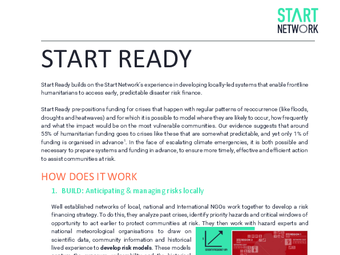Categories
Start Ready (by Start Network)
The Start Network is made up of more than 50 international and national NGOs across five continents. Start Network’s vision of the humanitarian system is one that is more proactive, innovative, and locally driven, in which people receive better quality humanitarian assistance and communities are more resilient to disaster. Since 2014 Start Network has operated the world’s fastest rapid response pooled fund, called the Start Fund which releases funding to small and medium crises at the latest 72 hours after a crisis has occurred. Based on this rich experience – which includes funding for response and anticipatory action – the Start Network has now launched a new financing system called Start Ready.
Start Ready pre-positions funding for crises that happen with regular patterns of reoccurrence (like floods and droughts) and for which it is possible to model where they are likely to occur, how frequently and what the impact would be on the most vulnerable communities. Evidence generated by Start Network suggests that around 55% of humanitarian funding goes to crises like these that are somewhat predictable, and yet only 1% of funding is organised in advance. In the face of escalating climate emergencies, it is both possible and necessary to prepare systems and funding in advance, to ensure more timely, effective and efficient action to assist communities at risk.
Start Ready uses climate science to predict hazards before they turn into crises, pre-arranges plans and financing ahead of time. These systems are already active or in development in 8 countries protecting more than 450,000 people against drought, floods and heatwaves in countries such as Pakistan and Senegal. The first Start Ready pool will go live in 2022, allowing Start Network to scale these approaches, and use global finance principles such as risk pooling, to make prearranged funding stretch further – protecting up to 4 times as many people against predictable disasters.
You can read more about Start Ready and how it works in the summary document below.
Photo by Save the Children Mongolia


